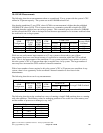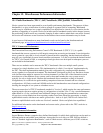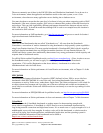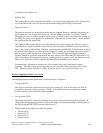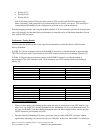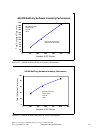
of printers in the configuration. 70% of the remaining memory is allocated to the interactive pool; 30% to
the base pool.
A QPFRADJ value of 1 ensures that memory is allocated on the system in a way that the system will
perform adequately at IPL time. It does not allow for reaction to changes in workload over time. In
general, this value is avoided unless a routine will be run shortly after an IPL that will make adjustments
to the memory pools based on the workload.
When the system value is set to 2, adjustments are made as described, plus dynamic changes are made
as changes in workload occur. In addition to the pools mentioned above, shared pools (*SHRPOOLxxx)
are also managed dynamically. Adjustments are based on the number of jobs active in the subsystem
using the pool, the faulting rates in the pool, and on changes in the workload over the course of time.
This is a good option for most environments. It attempts to balance system memory resources based on
the workload that is being run at the time. When workload changes occur, such as time-of-day changes
when one workload may increase while another may decrease, memory resources are gradually shifted to
accommodate the heaviest loads.
When the system value is set to 3, adjustments are only made during the runtime, not as a result of an
IPL.
This is a good option if you believe that your memory configuration was reasonable prior to scheduling
an IPL. Overall, having the system value set to 2 or 3 will yield a similar effect for most environments.
When the system value is set to 0, no adjustments are made. This is a good option if you plan on
managing the memory by yourself. Examples of this may be if you know times when abrupt changes in
memory are likely to be required (such as a difference between daytime operations and nighttime
operations) or when you want to always have memory available for specific, potentially sporadic work,
even at the expense of not having that memory available for other work. It should be noted, however, that
this latter case can also be covered by using a private memory pool for this work. The QPFRADJ system
value only affects tuning of system-supplied shared pools.
19.5 Additional Memory Tuning Techniques
Expert Cache
Normally, the system will treat all data that is brought into a memory pool in a uniform way. In a purely
random environment, this may be the best option. However, there are often situations where some files
are accessed more often than others or when some are accessed in blocks of information instead of
randomly. In these situations, the use of "Expert Cache" may improve the efficiency of the memory in a
pool. Expert Cache is enabled by changing the pool attribute from *FIXED to *CALC. One advantage for
using Expert Cache (*CALC) is that the system dynamically determines which objects should have larger
blocks of data brought into main storage. This is based on how frequently the object is accessed. If the
object is no longer accessed heavily, the system automatically makes the storage available for other
objects that are accessed. If the newly accessed objects then become heavily accessed, the objects have
larger blocks of data placed in main storage.
Expert Cache is often the best solution for batch processing, when relatively few files may be accessed in
large blocks at a time or in sequential order. It is also beneficial in many interactive environments when
IBM i 6.1 Performance Capabilities Reference - January/April/October 2008
© Copyright IBM Corp. 2008 Chapter 19 - Misc Perf Information 307



